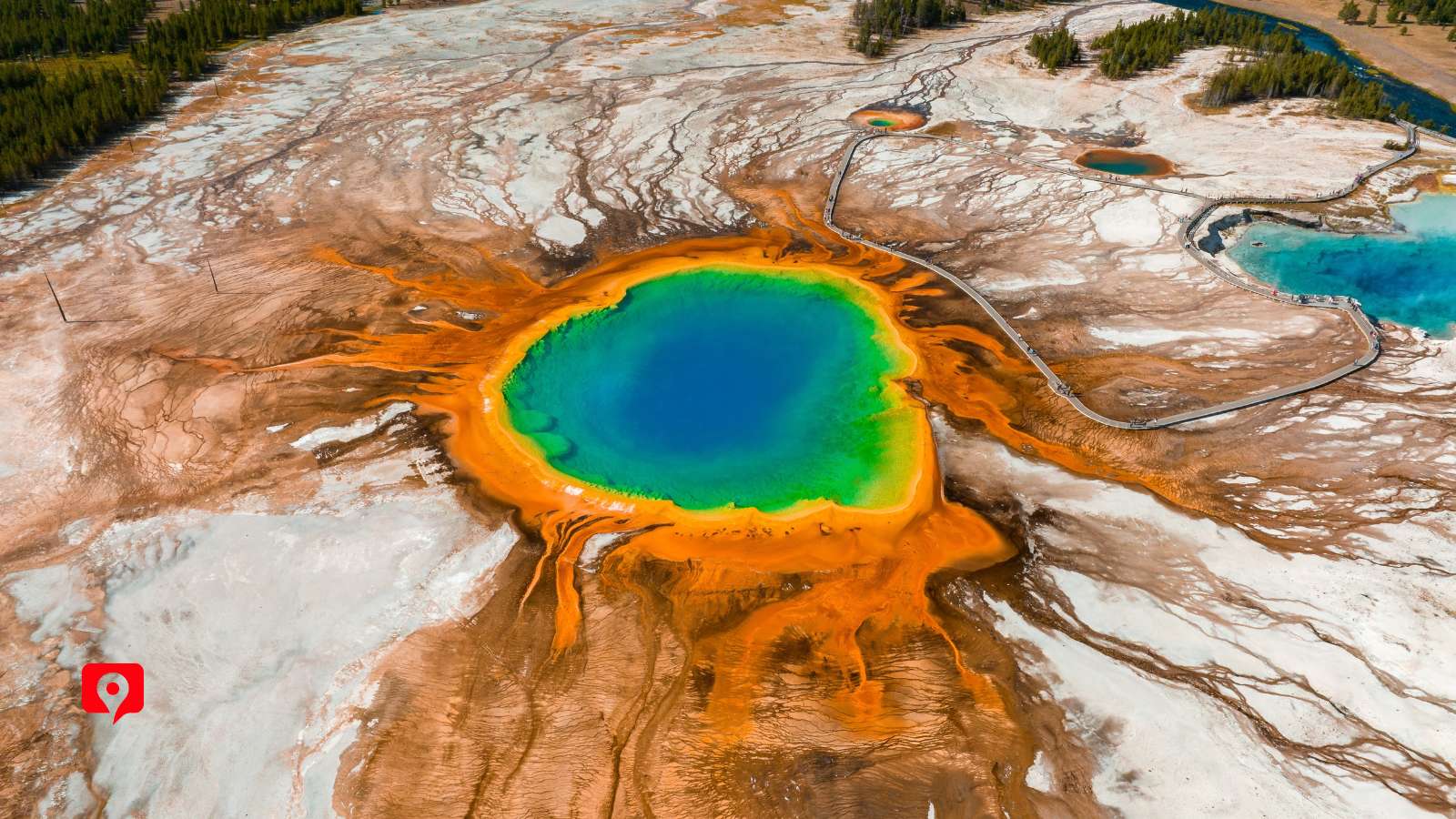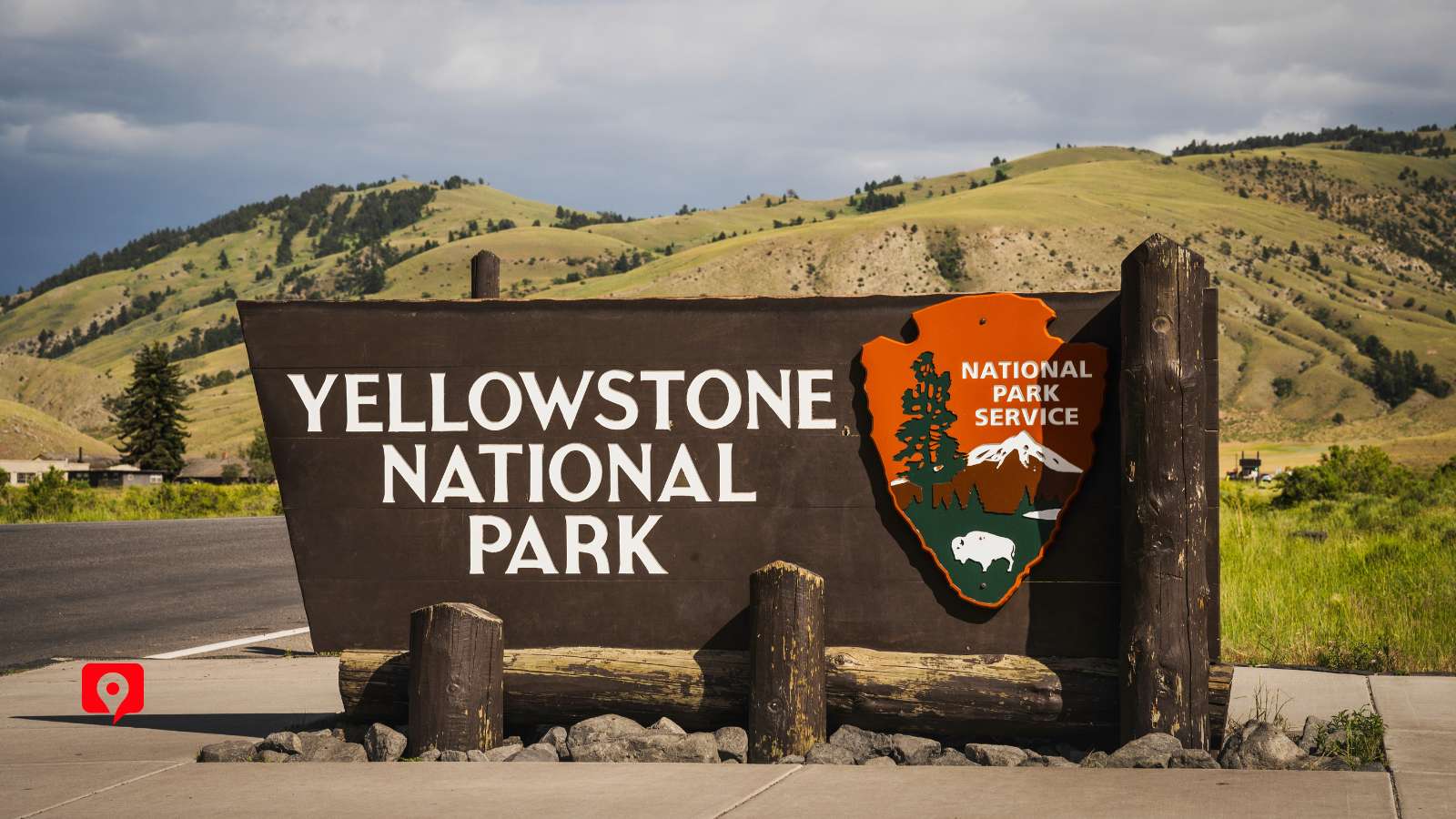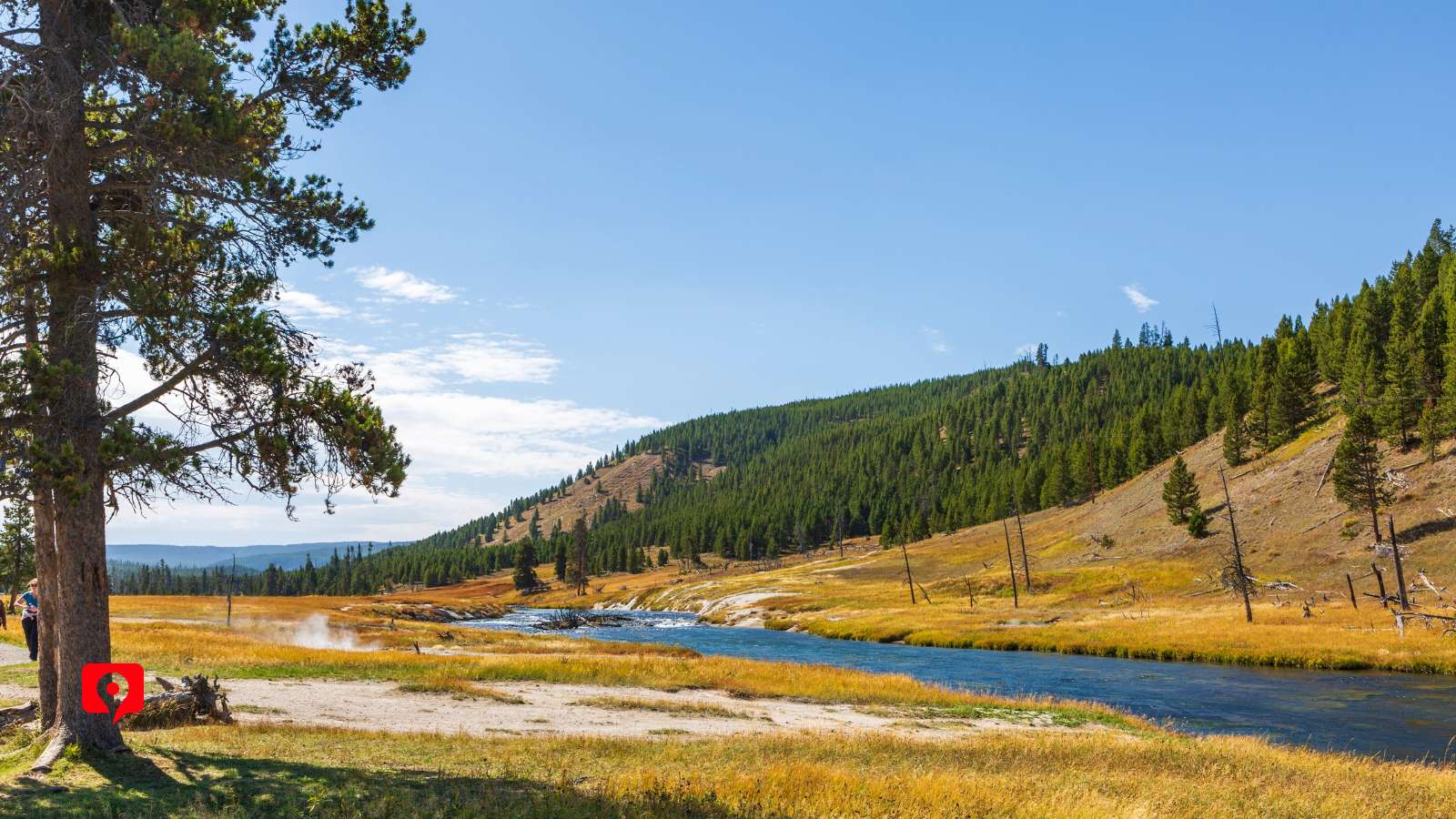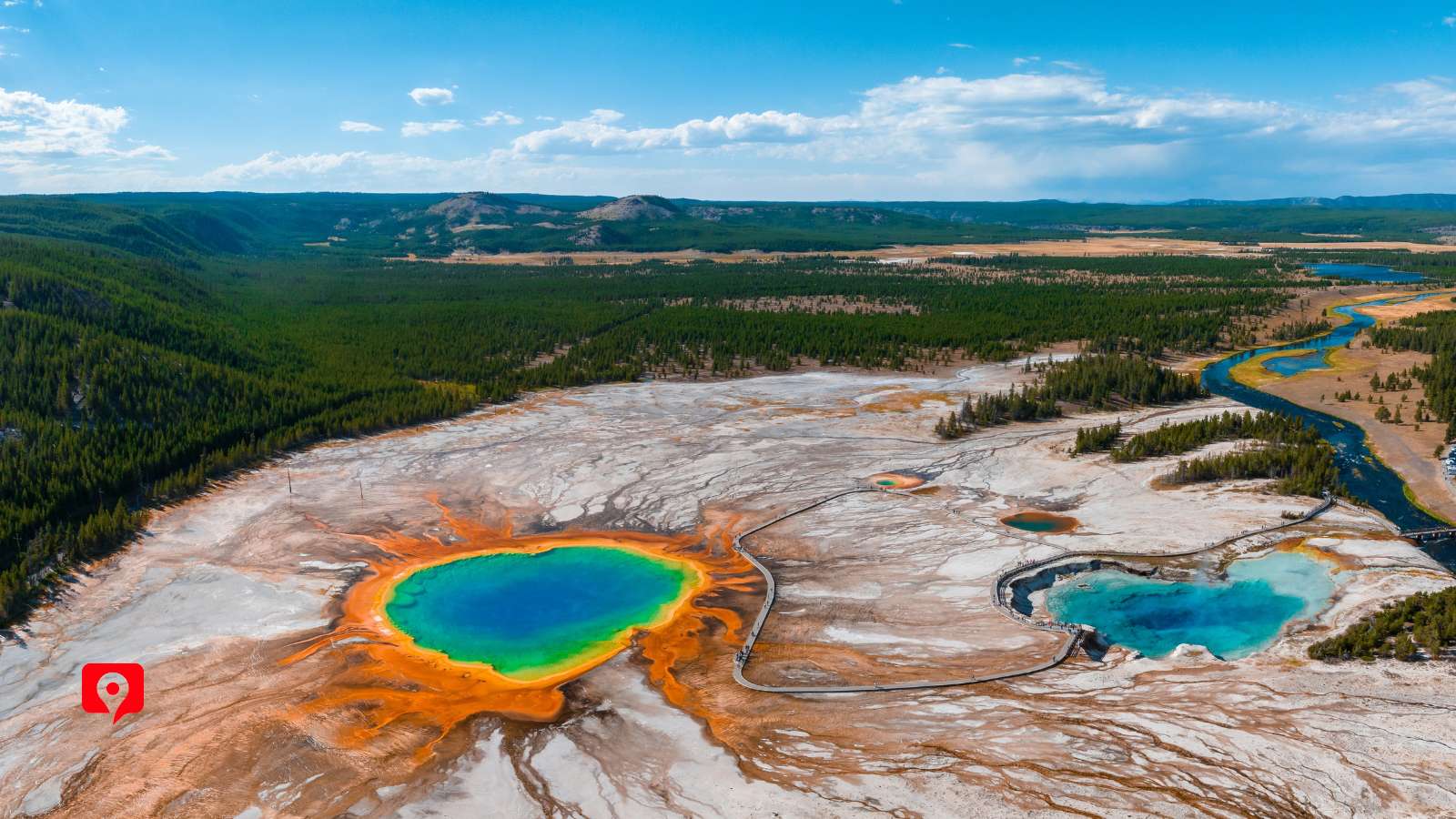00:00

The Grand Prismatic Overlook trail at Yellowstone National Park offers a breathtaking hiking experience, featuring a scenic route that passes the Firehole River and leads to a remarkable view of the park’s largest hot spring, the Grand Prismatic Spring. This 1.2-mile round-trip journey is considered easy to moderate, ascending through a lush forest before culminating at an overlook that presents an expansive view of the vibrant thermal spring below.
From this vantage point, hikers can see the full spectrum of the spring’s microbial mats, creating a brilliant display of oranges, yellows, greens, and blues. The trail doesn’t stop there; it continues towards Fairy Falls, offering a longer trek to one of the park’s most enchanting waterfalls.
For an optimal experience, pack water, wear sun protection, and choose sturdy footwear. The trail’s popularity may lead to crowds, but the combined beauty of the Firehole River, Grand Prismatic Spring, and Fairy Falls makes this hike an unforgettable Yellowstone adventure.
Reaching the Grand Prismatic Spring Overlook in Yellowstone National Park is straightforward, whether you’re flying in or driving from nearby cities. The overlook is accessible via the park’s main loop road, with the closest significant access points being the North, West, and South Entrances of the park.
West Yellowstone
Yellowstone Airport, situated in West Yellowstone, Montana, is the closest airport to the Grand Prismatic Spring Overlook. Just a few miles from the park’s West Entrance, this airport offers seasonal flights primarily via Delta and United Airlines from Denver and Salt Lake City. This is the most direct gateway for those planning to visit the Grand Prismatic Spring Overlook, with the Fairy Falls Parking Area—a starting point for the trail leading to the overlook—being easily accessible from this entrance.
Bozeman
Located in Bozeman, Montana, the Bozeman Yellowstone International Airport is about an hour and a half’s drive to the park’s North Entrance and less than two hours to the West Entrance, which leads to the Grand Prismatic Spring Overlook. As the largest airport in proximity to Yellowstone, it facilitates a broader range of flight options and provides essential rental car services, making it a versatile starting point for visitors aiming to explore the Grand Prismatic Spring as well as other park features.
Jackson
Jackson Hole Airport, positioned in Jackson, Wyoming, offers a scenic route into Yellowstone National Park, about a two-hour drive to the South Entrance and then onward to the park’s central features, including the Grand Prismatic Spring Overlook. Although this airport is a bit further compared to others, it allows visitors to experience the stunning landscapes of both Grand Teton and Yellowstone National Parks, making it an excellent choice for those who appreciate scenic journeys.
Most visitors to Yellowstone National Park’s Grand Prismatic Spring Overlook arrive by car, as there’s no public transportation within the park. This makes private vehicles essential for accessing key attractions. Rental cars are available at major airports near Yellowstone and Grand Teton, including Bozeman, Jackson Hole, and West Yellowstone. Alternatively, private bus tours offer a hassle-free way to visit major park features like the Grand Prismatic Spring Overlook, handling all travel logistics for those who prefer not to drive.

Entrance Fees
Visitors to the Grand Prismatic Spring Overlook in Yellowstone National Park must purchase a park pass, valid for seven consecutive days, at the park entrances or visitor centers, or online in advance. Depending on your travel plans and if you intend to visit multiple National Parks within a year, the America the Beautiful National Parks and Federal Recreational Lands Pass might be more cost-effective. This pass grants access to all U.S. National Parks, over 2,000 National Monuments, National Wildlife Refuges, National Historic Sites, and other federally managed lands.
Passes are complimentary for current U.S. military members and available at a reduced price for seniors aged 62 years or older. Seniors can also enjoy a 50% discount at certain campgrounds.
Have Kids in the 4th Grade?
You and your family can get free access to hundreds of parks, lands, and waters for an entire year!
When planning a visit to the Grand Prismatic Spring Overlook in Yellowstone, your accommodation choices depend on how long you plan to stay, which park entrances you’ll use, reservation timing, and your comfort preferences.
Accommodations within the park include hotel-style rooms, rustic cabins, and luxury suites, often booked far in advance. Reservations for the following summer open on May 1st and can fill up a year ahead, so flexibility with travel dates is key.
For a closer-to-nature experience, Yellowstone offers twelve campgrounds, five of which allow advance reservations. The rest are first-come, first-served; arriving early in the morning during peak season is advisable, especially for those without reservations. Note that RV length restrictions apply in many park campgrounds.
Early planning and booking are essential, especially if you wish to stay within the park boundaries. Choosing a location that aligns with your park entry points will ensure a more convenient and enjoyable visit to Yellowstone’s natural wonders.
Outside the Park
Securing lodging inside Yellowstone National Park can be challenging, especially during the peak summer months. Fortunately, there are numerous accommodation options available just outside the park that cater to various budgets and preferences.
West Yellowstone, Montana, located close to the West Entrance, is the most convenient town for accessing the Grand Prismatic Spring Overlook. It offers a variety of lodging, dining, and entertainment options, making it a popular base for visitors. Gardiner, Montana, near the North Entrance, also provides several accommodation choices and easy park access. For those exploring Yellowstone’s eastern attractions, Cooke City and Cody, Wyoming are excellent choices. Both towns offer a range of lodgings and are well-positioned to serve as basecamps for park exploration.
Visiting the Grand Prismatic Spring Overlook in Yellowstone National Park offers distinct experiences throughout the year. While Yellowstone is open year-round, accessibility is reduced in winter due to snow. The peak visitor months are July and August, when the parks are most crowded. However, the shoulder months of April through May and September through October are ideal for fewer crowds and pleasant weather, though visitors should be prepared for chilly temperatures that can drop to the 30s at night, even in summer.
Summer brings frequent thunderstorms and higher elevation trails may remain snow-covered until late May or early June. Winter, though requiring more preparation due to limited services, provides a unique opportunity for cross-country skiing and wildlife spotting, with the added allure of seeing features like Old Faithful with few other visitors around. Each season offers a different perspective of the parks’ natural beauty, so choose your visit based on the kind of experience you’re looking for and the activities you plan to enjoy.

The Grand Prismatic Spring Overlook in Yellowstone National Park offers a mesmerizing view of the park’s largest hot spring. This 1.2-mile round-trip trail leads to a viewpoint where you can enjoy the vibrant colors of the spring. Allocate 1 to 2 hours for this hike, which is relatively easy and provides fantastic photo opportunities, especially in the early morning or late evening when crowds thin and lighting is optimal.
Visiting during these times not only reduces interactions with other tourists but also enhances the spring’s vivid hues. The overlook offers a chance to experience the grandeur and stunning palette of the Grand Prismatic Spring in a peaceful setting, making it a perfect spot for those seeking the serene beauty of one of Yellowstone’s most famous sights.

To avoid crowds at the Grand Prismatic Spring Overlook in Yellowstone, visiting outside the peak summer months (July and August) is highly recommended. If summer travel is unavoidable, consider visiting popular attractions early in the morning or late in the evening. Additionally, exploring lesser-known trails and the backcountry can offer a more secluded experience.
Staying within the park can also significantly reduce daily travel time and increase your chances of experiencing quieter moments. Don’t hesitate to seek advice from park rangers or locals who can provide insights on less crowded spots and unique activities away from the main tourist areas. This strategy will help you enjoy the natural beauty of Yellowstone with fewer interruptions and a more personal connection to the environment.

Grand Prismatic Spring Overlook
The Grand Prismatic Spring Overlook offers a stunning view of Yellowstone’s largest hot spring. This vantage point allows visitors to appreciate the spring’s massive size and vivid coloration, ranging from deep blues to vibrant oranges, created by microbial mats around its edges. Easily accessible via a short hike, the overlook provides a panoramic view that encapsulates the extraordinary beauty and geological uniqueness of the area.
Fairy Falls
The Grand Prismatic Spring Overlook offers a stunning view of Yellowstone’s largest hot spring. This vantage point allows visitors to appreciate the spring’s massive size and vivid coloration, ranging from deep blues to vibrant oranges, created by microbial mats around its edges. Easily accessible via a short hike, the overlook provides a panoramic view that encapsulates the extraordinary beauty and geological uniqueness of the area.
Firehole River
The Firehole River, named for its misty, smoke-like steam, flows through Yellowstone National Park, serving as a vital link between several geyser basins. Originating from renowned thermal features like the Grand Prismatic Spring and Old Faithful, its waters cool quickly, creating excellent conditions for fishing. The Firehole joins the Gibbon River to form the Madison, which ultimately contributes to the Mississippi River system, draining into the Atlantic Ocean, showcasing a dramatic journey from Yellowstone’s geothermal heart to the sea.
Capture the breathtaking beauty of Grand Prismatic Spring from the overlook. The unique aerial perspective allows for stunning photographs of the thermal gradients and vivid colors. The best shots often include the steam rising from the hot spring, which adds a mystical quality to the images. Bring a polarizing filter to reduce glare on the water and enhance the natural colors.
The area around Grand Prismatic is part of a larger ecosystem that supports a variety of wildlife. Early morning hikers might see elk grazing nearby or bison walking the plains. Birdwatchers can look for raptors and waterfowl that frequent the area. Always maintain a safe distance from wildlife and use binoculars or a zoom lens to observe them closely.
Crater Lake National Park is home to a diverse array of animals, including the rare and elusive Sierra Nevada red fox, black bears, elk, and bald eagles, as well as various small mammals and birds. he natural habitats around the lake and the surrounding forests provide excellent opportunities to observe these creatures in their natural environment. Early mornings or late evenings are ideal for spotting wildlife, allowing visitors to quietly observe as the park’s vibrant ecosystem comes to life.
Extra Layers: The environment around Grand Prismatic Spring can experience significant temperature swings. Layering your clothing with a fleece and a lightweight jacket can help you adjust to varying conditions, whether it gets windier, hotter, or colder. This ensures you stay comfortable throughout your hike.
Footwear: Proper footwear is critical for a safe and comfortable hike. Choose shoes with good traction, such as trail runners or lightweight hiking boots, which are ideal for handling the rocky and sandy patches of the trail. Avoid flip-flops or open-toed sandals, as the trail terrain includes rough patches and prickly plants.
Daypack: A comfortable daypack is vital for carrying essentials such as an extra layer, water, snacks, and a headlamp.
Portable Phone Charger and Cable: Since cell service can be spotty, having a portable charger ensures you can keep your phone charged, especially useful if you plan to take photos.
First Aid Kit: Include items such as band-aids, antiseptic ointment, gauze, and adhesive tape. Adding an emergency whistle and basic survival tools can also be beneficial.
Water Bottles: Stay hydrated by carrying enough water, especially since there are no water sources directly on the trails.
Hiking Poles: Lightweight hiking poles can help maintain balance and provide support on the uneven terrain of the trail.
Sun Protection: Pack a broad-brimmed hat, sunscreen, and sunglasses to protect against the sun’s rays.
Plastic Bag: Carry a plastic bag to pack out any trash you generate, helping keep the park clean for others.
Please fill out this form and let us know
17 Mile Drive Acadia Alberta Arches ARIZONA AUSTRALIA Badlands Banff Kamploos Big Bend National Park Big Island Big Sky Drive Big Sur Black Canyon Black Hills Blue Lagoon Bryce Canyon CALIFORNIA CANADA Canadian Rockies Canyonlands Capitol Reef Catskills COLORADO Crater Lake Cuyahoga Valley Death Valley Delicate Arch Everglades FLORIDA Florida Keys Glacier Grand Canyon Grand Prismatic Grand Teton Haleakala HAWAII Hidden Valley Hikes Honolulu Iceland Iceland Golden Circle Itineraries Joshua Tree Kauai Lake Tahoe Lassen Volcanic Lodging Louisiana MAINE Maui MICHIGAN Montana Monument Valley Mount Lemmon Mount Rainier Mount Rushmore National Park NEVADA New Mexico New River Gorge NEW YORK NORTH CAROLINA North Cascades North Dakota Oahu Ohio Old Faithful Ontario OREGON Point Reyes Redwood Reykjanes Peninsula Rocky Mountain Route 66 Saguaro Santa Fe Sedona Smokies Snæfellsnes Peninsula Sonoma And Napa Valley SOUTH DAKOTA Tech Tips TENNESSEE Texas Theodore Roosevelt Travel Tips Trip Planners USA UTAH Videos Waikiki WASHINGTON West Thumb West Virginia White Sands Wildlife WYOMING Yellowstone Yosemite Zion
